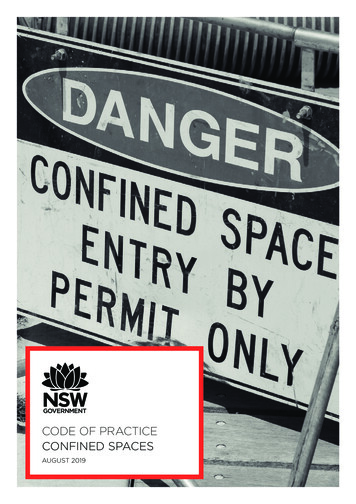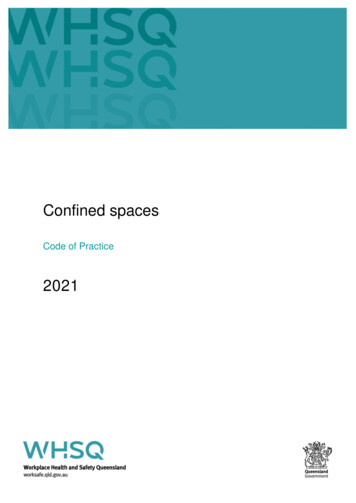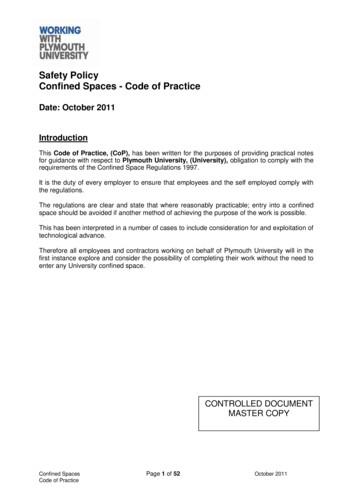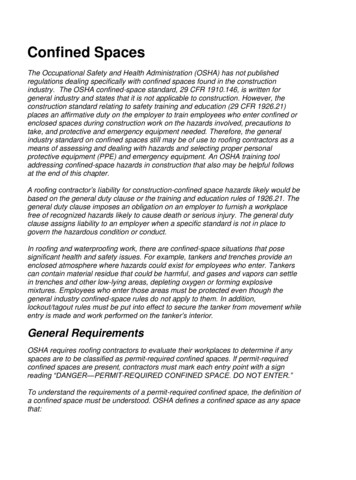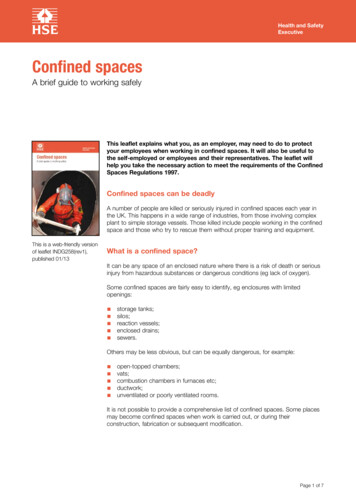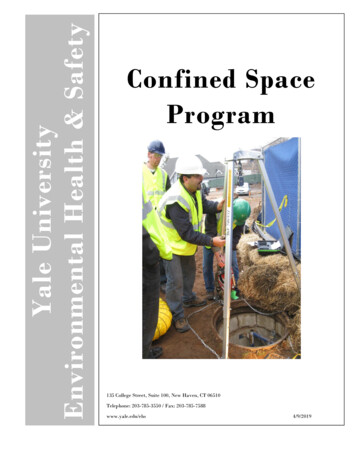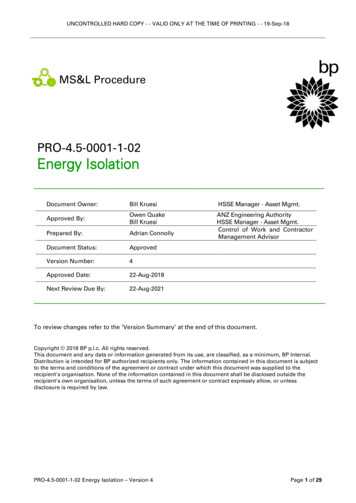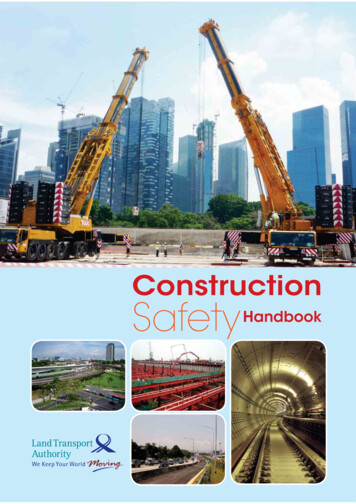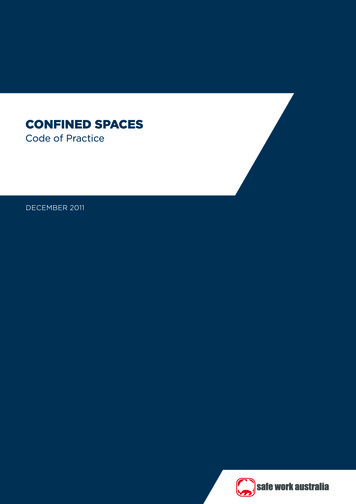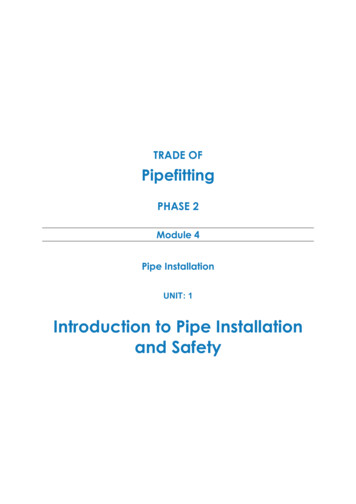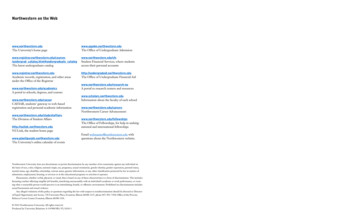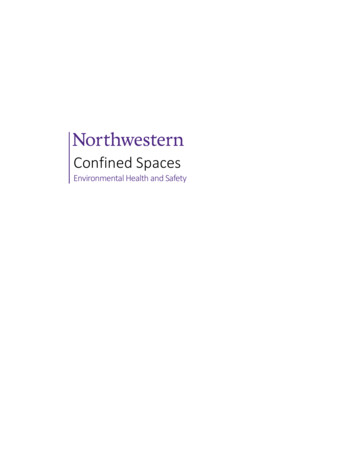
Transcription
Confined SpacesEnvironmental Health and Safety
Table of ContentsI.Purpose . 2II.Scope . 2III. Responsibilities . 2IV. Non-Permit Confined Space Entry . 5V.Permit-Required Confined Space Entry . 5VI. Signage . 7VII. Communication . 7VIII. Air Monitoring . 8IX. Rescue . 8X.Hazardous Energy Isolation. 9XI. Reclassification Procedures . 10XII. Alternate Entry Procedures. 10XIII. Training . 11XIV. Recordkeeping . 12XV. Regulatory Authority and Related Information . 12XVI. Contact . 12Appendix 1 – Confined Space Assessment Form . 13Appendix 2 – Guidelines for Contractors Working in Confined Spaces . 15Appendix 3 – Confined Space Entry Permit . 16Appendix 4 – Permit-Required Confined Space Reclassification Form. 17Appendix 5 – Permit-Required Confined Space Alternate Entry Form. 18Appendix 6 – Bump Test and Calibration Log Sheet . 19Appendix 7 – Utility Tunnels . 20Confined SpacesEnvironmental Health and Safety September 20211
I.PurposeThis program establishes a process to protect employees from the hazards associated with entryinto confined spaces and provides guidance for the safe access and entry into, working inside,and egress from confined spaces.II.ScopeThis program applies to all contractors and Northwestern employees who have to perform workin a confined space.A. DefinitionConfined spaces are defined as areas that:i.Are large enough for an employee to enter and perform work,ii.Have limited or restricted means for entry or exit, andiii.Are not designed for continuous occupancy.Examples of confined spaces at Northwestern are sewers, manholes, tunnels, tanks,boilers, transformers, pipes, excavations, elevator pits, vaults, and ducts. For thepurpose of this program, there are two classifications of confined spaces:i.Non-permit confined space – confined space that meets the definition of aconfined space (above), but does not meet the requirements for a permitrequired confined space (below).ii.Permit-required confined space – confined space that has one or more of thefollowing characteristics:a. Contains or has a potential to contain a hazardous atmosphere,b. Contains a material that has the potential for engulfing an entrant,c. Has an internal configuration such that an entrant could be trapped orasphyxiated by inwardly converging walls or a floor that slopesdownward and tapers to a smaller cross section, ord. Contains any other recognized, serious safety or health hazard.B. Evaluationi.Assessments must be conducted to determine whether a confined space isclassified as a non-permit confined space or a permit-required confined space(see Appendix 1).ii.Confined space assessments and photos are available on Environmental Healthand Safety’s SharePoint website and are accessible to authorized departments.iii.When there are changes in the use or configuration of a non-permit confinedspace, or when certain operations (e.g., welding, steam lines, chemicals) mightintroduce or create new hazards to entrants, the confined space must be reevaluated prior to entry. If necessary, the space will be reclassified as a permitrequired confined space.III.ResponsibilitiesA. Environmental Health and Safety (EHS)i.Review, audit, and revise this program and permit process annually or anytimedeemed necessary.ii.In collaboration with Facilities and Information Technology, assess new andexisting confined spaces.iii.Provide guidance and technical assistance as needed.Confined SpacesEnvironmental Health and Safety September 20212
iv.Maintain the SharePoint database of confined space assessments.B. Departments and Unitsi.Department chief, supervisor, or designee must approve entry into permitrequired confined spaces, including contractors (see Appendix 2 for guidelinesregarding contractors working in confined spaces).ii.Ensure employees are fully informed, authorized, and trained in confined spaceentry requirements and procedures as outlined in this program.iii.Prevent unauthorized entry into permit-required confined spaces throughtraining, signage, and security measures.iv.Monitor employees’ need for additional or refresher training, based uponassigned duties, changes in confined spaces, or changes to this program.v.Collaborate with EHS to ensure each contractor’s Confined Space Program andpermit process is compliant with regulatory and Northwestern requirements.C. Project Managersi.Inform contractors of work that involves any confined space entry and provideassessments for those spaces.ii.Collaborate with Information Technology and/or Facilities when energyshutdowns or lifesaving impairments are necessary.iii.Collaborate with EHS to ensure each contractor’s Confined Space Program andpermit process is compliant with regulatory and Northwestern requirements.iv.Inform and provide contractors with the Northwestern Confined SpacesProgram and specific procedures developed for confined space entries.v.For more guidelines regarding contractors working in confined spaces, seeAppendix 2.D. Authorized Entrantsi.Successfully complete confined space entry training.ii.Know the hazards that may be faced during entry, including information on themode, signs or symptoms, and consequences of exposure.iii.Conduct assigned tasks in a safe manner at all times.iv.Wear appropriate personal protective equipment correctly.v.Maintain communication with the attendant to alert regarding the need toevacuate the space.vi.Exit the space as quickly as possible whenever:a. An order to evacuate is given by the attendant or entry supervisor,b. An entrant recognizes any warning signs or symptoms of exposure to adangerous situation,c. An entrant detects a prohibited condition, ord. An evacuation alarm is activated.vii.Report any injuries, illnesses, questions, or any unsafe working conditions to thedepartment Supervisor.E. Authorized Attendantsi.Successfully complete confined space entry training.ii.Know the hazards that may be faced during entry, including information on themode, signs or symptoms, and consequences of exposure.iii.Conduct assigned tasks in a safe manner at all times.iv.Be aware of possible behavioral effects of hazard exposure of entrants.v.Accurately record all data on the permit (e.g., names of individuals, date, time ofentry, atmospheric data) and be the sole person responsible for the permit.Confined SpacesEnvironmental Health and Safety September 20213
vi.vii.viii.Continuously maintain an accurate count of entrants in the space.Ensure an attendant is always present while entrants are in the space.Maintain communication with the entrants to assess entrant status and alertentrants of the need to evacuate immediately under the following conditions:a. If an attendant detects a prohibited condition,b. If an attendant detects the behavioral effects of hazard exposure in anentrant,c. If an attendant detects a situation outside the space that couldendanger the entrants, ord. If an attendant cannot effectively and safely perform all theaforementioned duties.ix.Summon rescue or other emergency services if entrants need assistance toescape from the space.x.Ensure unauthorized entrants do not enter the permit-required confined space.xi.Report any injuries, illnesses, questions, or any unsafe working conditions to thedepartment Supervisor.F. Authorized Entry Supervisorsi.Successfully complete confined space entry training.ii.Know the hazards that may be faced during entry, including information on themode, signs or symptoms, and consequences of exposure.iii.Conduct assigned tasks in a safe manner at all times.iv.Verify all tests specified by the Confined Space Entry Permit have beenconducted and all procedures and equipment specified on the permit are inplace prior to endorsing the permit and allowing entry to begin.v.Terminate the entry permit, whenever warranted.vi.Verify rescue services are available and a means to summon them is operable.vii.Report any injuries, illnesses, questions, or any unsafe working conditions to thedepartment Supervisor.G. Contractorsi.Provide a copy of a site-specific/project-specific confined spaces program toNorthwestern department project managers and EHS.ii.Confined Spaces programs must meet or exceed the minimum requirements setforth in this program, in addition to the OSHA General Industry and/or ConfinedSpaces in Construction regulations, as applicable.iii.Obtain copies of all necessary confined space assessments and coordinate allconfined space entries with Northwestern project managers, including whenboth Northwestern and contractor personnel will be working in or near confinedspaces; contractors must receive authorization from Northwestern Facilities orInformation Technology prior to entry in a confined space.iv.Ensure employees are properly trained in confined space entry procedures.v.Provide the necessary equipment, personal protective equipment, personnel,and resources necessary for safe entry into confined spaces, including airmonitoring equipment and rescue equipment/services.vi.Post permits at confined space entry sites for the duration of the entry.vii.Contractors must use their own confined space permits and provide completedpermits to Northwestern project managers.viii.Inform Northwestern project managers of any hazards confronted or created inthe confined space.Confined SpacesEnvironmental Health and Safety September 20214
ix.x.xi.IV.Develop rescue procedures specific to the space(s) entered (see Section IX).In the event of an emergency requiring confined space rescue, the authorizedentry supervisor or attendant will immediately notify emergency services.Provide a scope of work to Northwestern project managers and EHS, prior toentry into confined spaces on Northwestern property that are not controlled ormaintained by Northwestern (e.g., city sewers, ComEd electrical vaults).Non-Permit Confined Space EntryA. Before entry into non-permit confined spaces, authorized entry supervisors mustevaluate the scope of work and determine whether conditions will change that mightmake the space a permit-required confined space. Examples include welding, workingwith hazardous chemicals, introduction or intrusion of a hazardous substance (e.g.,flooding) or atmosphere (e.g., active steam release), and known or assumed structuralfailure. If such conditions are expected, suspected, or develop, supervisors must contactEHS to assist with a hazard assessment to conduct a permit entry.B. If non-permit confined spaces have no hazards, entry can be done without using thepermit system.C. Only trained and authorized individuals may enter and perform work inside non-permitrequired confined spaces.V.Permit-Required Confined Space EntryA. Pre-Entryi.Notify EHS at ehs@northwestern.edu prior to entry into a permit-requiredconfined space.ii.Notify University Police prior to entry into a permit-required confined space;this information must be noted on the entry permit.a. Evanston Campus:(847) 491-3254b. Chicago Campus:(312) 503-3456iii.Review the confined space assessment (see Appendix 1 for a blank assessment)and scope of work to determine the permit requirements.iv.Evaluate the work activities and conditions, and develop a Safe OperatingProcedure (SOP) (see Safe Operating Procedure Guide and Safe OperatingProcedure Template) that addresses the work conditions, hazards,responsibilities, assigned duties, communication, and rescue/emergencyservices procedures.v.Approved SOPs and applicable confined space assessment forms must beemailed, with as much advanced notice as possible, to:a. Evanston Fire Department at rg, and wmuno@cityofevanston.org, orb. Chicago Fire Department at andrew.mcgill@cityofchicago.orgvi.Review the SOP and applicable confined space assessment(s) andlockout/tagout procedure(s) with all parties involved during a pre-work briefing.vii.Test all air monitoring equipment before each entry into a confined space inaccordance with the manufacturer’s instructions, and calibrate if necessary.viii.No employee may enter a confined space until all identified hazards areeliminated or controlled and acceptable entry conditions have been established.Confined SpacesEnvironmental Health and Safety September 20215
ix.x.xi.xii.B. Entryi.ii.iii.iv.v.vi.vii.viii.ix.x.Because confined spaces may be immediately dangerous to life and health(IDLH), continuous forced air ventilation must be used to eliminate thepotentially hazardous atmosphere:a. Air must be taken from a clean source and continued until all employeeshave left the space.b. If the minimum oxygen content of 19.5% cannot be maintained byforced air ventilation and the environment is oxygen-deficient, consultwith Facilities Operations and EHS.c. This method cannot be used if asbestos is present in the space.Before authorized entrants enter the space, the internal atmosphere must betested with a calibrated, direct-reading instrument (see Section VIII).a. Retain and record all air monitoring test/calibration data on the permit.b. The entry supervisor must ensure air monitoring has been conductedwithin 15 minutes prior to entering any permit-required confined space.c. Communicate all air monitoring results to all entrants or theirauthorized representative.Submit the completed permit (see Appendix 3 for a blank permit) to EHS forreview and approval in-person or by such means as emailing or texting a photoof the permit. EHS will evaluate the permit to ensure all requirements are metprior to entry.Post the authorized confined space permit at the entry portal, or by any otherequally effective, conspicuous manner, prior to beginning work.Only trained and authorized employees may enter a confined space or act as anattendant or supervisor; measures must be in place to prevent unauthorizedentries.During permit-required confined space entries, an attendant must be present atall times; the attendant cannot perform any other tasks that could potentiallyinterfere with his/her abilities to provide any/all support necessary to theentrant(s).Smoking is prohibited in confined spaces and near the entrance/exit area.Keep running vehicles away from the permit workspace.Maintain constant visual or voice communication between the attendant andentrants entering a permit-required confined space using intrinsically safecommunications (see Section VII).Access spaces with engulfment hazards away from affected areas or by topentry only.Protect all openings to confined spaces with barriers when hatches, covers, orlids are removed to protect entrants and others from potential hazards.When the possibility of a release of hazardous energy exists, appropriatelockout/tag out procedures must be utilized (see Section X).Utilize all required personal protective equipment, as indicated in the SOP.In the event a hazardous atmosphere or condition is detected or suspected atany time during a confined space entry, all personnel must exit the spaceimmediately and measures must be implemented to protect employees fromthe hazards before any subsequent entries take place; department supervisorsand EHS must be notified.Confined SpacesEnvironmental Health and Safety September 20216
xi.If an emergency rescue becomes necessary or in the event of an injury, theEntry Supervisor or Attendant must call 911 immediately and provideinformation, guidance, and assistance as necessary. Northwestern employeesare not permitted to enter a confined space to perform a rescue under anycircumstances.C. Post-Entryi.When all work is complete and personnel have exited the confined space, theEntry Supervisor must:a. Ensure the worksite is returned to safe conditions,b. Close out the permit,c. Notify University Police and EHS the entry has been completed, andd. Document any problems encountered during the entry.ii.Provide copies of all SOPs, permits, and any other relevant documentation (e.g.,hot work permits) to EHS for post-entry review, who will:a. Evaluate the entry permit and any other relevant documents to ensurethey were completed properly,b. Review the SOP to ensure all personnel involved signed it,c. Provide immediate feedback and guidance to supervisors for anydeficiencies identified, andd. Maintain all relevant documentation for at least three years to facilitatethe review of the Confined Spaces Program.VI.SignageA. For all permit-required confined spaces, post appropriate danger signage at the entryportal, hatch, cover, or equally effective location.B. When feasible, provide locks on all confined space access points.C. Steam, chilled water, and hot water vault access points must be marked with the vaultnumber, in conspicuous manner, which corresponds to the system drawings andconfined space assessments; paint, tags, or any other effective means of marking andidentifying the vaults may be used.D. When infeasible to post permanent danger signage at confined space entry points (e.g.,outdoor steam vaults, hot water vaults, chill water vaults), post temporary appropriatedanger signage at the access point(s) when the access points are open.VII.CommunicationA. Departments and contractors must ensure two-way communication is available duringall permit-required confined space entries and are responsible for ensuring adequatecommunication:i.Between those inside the confined space,ii.Between those inside the confined space and those outside, andiii.To summon emergency responders in the event of an emergency.B. Examples of acceptable forms of communication are:i.UHF portable radio;ii.Cellular phone;iii.Verbal;iv.Tapping;v.Fixed telephone, if available;Confined SpacesEnvironmental Health and Safety September 20217
vi.Visual (e.g., hand signals); andvii.Tugs on a lifeline.C. Cellular service and UHF radio coverage may be limited in certain confined spaces atNorthwestern. Effective communication is required for all permit-required confinedspace entries.VIII.Air MonitoringA. Departments are responsible for maintaining, calibrating, and operating all airmonitoring equipment according to the manufacturer’s instructions.i.Prior to performing air monitoring for permit-required confined space entry,perform a bump test or full calibration in accordance with the manufacturer’sinstructions using the appropriate test gas.ii.Adjust instruments that fail a bump test by a full calibration before further use.iii.Calibration of air monitoring equipment must be performed monthly anddocumented.B. Before authorized entrants enter the space and while entrants work in the space,atmospheric conditions must remain within the following limits:i.Oxygen: between 19.5% and 23.5%ii.Lower Explosive Limit (LEL): less than 10%iii.Carbon Monoxide (CO): less than 35 ppm (parts per million)iv.Hydrogen Sulfide (H2S): less than 10 ppm (parts per million)C. Atmospheric conditions must be tested at least every 2 hours, as necessary based onthe hazards present, and anytime deemed necessary by any member of the confinedspace entry team.D. Atmospheric test results must be documented on entry permits.IX.RescueA. Rescue Proceduresi.Rescue procedures are required for all permit-required confined space entries.ii.The fire department is considered a back-up rescue service and must be notifiedprior to any confined space entry as outlined in Section V.iii.If an entrant requires rescue from a confined space, the Entry Supervisor orAttendant must call 911 immediately and report the incident as a “confinedspace rescue.”iv.Northwestern employees are not permitted to enter a confined space to performa rescue under any circumstances.B. Rescue MethodsThere are two types of rescue: entry and non-entry.i.Only trained 3rd party rescue professionals can perform entry rescue.ii.Trained attendants and entry supervisors may perform non-entry rescue withthe use of a retrieval system.C. Rescue Method Selectioni.Retrieval systems, such as tripods, must be set-up and used whenever anemployee enters a permit-required confined space to facilitate non-entryrescue, if needed.ii.Retrieval systems must include a chest or full-body harness, retrieval line, and amechanical retrieval device (if the vertical space is over 5 feet deep).Confined SpacesEnvironmental Health and Safety September 20218
iii.iv.v.vi.X.Only trained and authorized personnel may utilize retrieval equipment, andequipment must be inspected prior to use.Retrieval equipment owned by departments and units must be inspectedannually by a competent person and in accordance with the Fall Protectionprogram.The retrieval system is not required if the equipment would increase the overallrisk of entry or would not contribute to the rescue of the entrant.If non-entry retrieval equipment will be ineffective (e.g., horizontal exit points,piping or equipment obstructions), a means of entry rescue must be in place,such as a standby rescue team. Confined space assessments must becommunicated to rescue teams, and the rescue team must review and sign theSafe Operating Procedure. The fire department cannot be designated as astandby rescue team but must always be notified immediately in the event of anemergency to provide additional support.Hazardous Energy IsolationEvery effort must be made to avoid entering confined spaces by such methods as reconfiguringor relocating equipment, using cameras for inspections, or utilizing extension tools to operateequipment. If confined spaces must be entered, hazardous energy must be isolated prior toentry.A. When hazardous energy must be isolated, the procedures outlined in Northwestern’sControl of Hazardous Energy (Lockout/Tagout) Program must be followed.B. Isolation of all hazardous energy is required to reclassify a permit-required confinedspace to a non-permit required confined space.C. Isolation or de-energization of hazardous energy is required using documentedlockout/tagout procedures. Examples of conditions when hazardous energy must beisolated include:i.Line breaking;ii.Visible or suspected steam leaks;iii.Corroded piping;iv.Installation, repair, or demolition of system components;v.Adjusting or tightening compression seals, such as flanges;vi.Operation of valves;vii.Inspections or surveys;viii.Draining or releasing hot water from steam traps or condensate lines;ix.Any work in normally flooded spaces, such as boilers and water tanks;x.When steam or condensate is enclosed in sealed piping and piping components(e.g., valves, steam traps); andxi.When there is imminent risk of direct exposure to contained hazards.D. Single-valve isolation of flowable materials (e.g., steam, water) is not permitted.E. Flowable materials (e.g., steam, water) must be isolated by the use of the followingtechniques:i.Blanking or blinding;ii.Misaligning or removing sections of lines, pipes or duct; oriii.Use of a double block and bleed system.Confined SpacesEnvironmental Health and Safety September 20219
F. Isolation of hazardous energy is not required in permit-required confined spaces wherethere is no foreseeable exposure to physical hazards (e.g., no visible or suspected steamleaks, no corroded piping, no other known conditions that could result in the potentialrelease of hazardous energy) and when physical hazards are contained or enclosed, suchas:i.Electrical hazards that are enclosed in conduit or enclosures.ii.Flowable physical hazards, such as steam, water, or liquids, that are:a. Contained in tanks;b. Enclosed in mechanically and structurally continuous runs of piping,without connections such as flanges, valves, and traps; andc. Where there is no imminent risk of direct exposure to the containedhazard.iii.If at any time a hazard is suspected, develops, or is discovered while in the space(e.g., discovery of a steam leak, damage, or corrosion), the space must beimmediately evacuated and re-evaluated.XI.Reclassification ProceduresA. A permit-required confined space may be reclassified as a non-permit confined space ifthe space poses no actual or potential atmospheric hazards and all hazards within thespace are eliminated without entry into the space.B. Permit-required confined spaces such as steam vaults are not eligible forreclassification.C. A reclassification form (see Appendix 4) must be utilized to reclassify a permit-requiredconfined space to a non-permit confined space.D. An SOP is required for confined space entries utilizing the reclassification form.E. If it is necessary to enter the permit space to eliminate hazards, such entry shall beperformed using a confined space entry permit (see Appendix 3). If testing andinspection during that entry demonstrate that the hazards within the permit space havebeen eliminated, the permit space may be reclassified as a non-permit confined spacefor as long as the hazards remain eliminated.F. Control of atmospheric hazards through forced air ventilation does not constituteelimination of atmospheric hazards.G. If hazards arise within a permit space that has been declassified to a non-permit space,the space must be evacuated immediately and reevaluated to determine whether itmust be reclassified as a permit space.H. Entry operations are immediately canceled when the work is completed, a conditionthat is not allowed under the form arises, or after 8 hours. Re-entry into the spacerequires a permit or new reclassification form.XII.Alternate Entry ProceduresA. Alternate entry procedures may be utilized to enter a permit-required confined space ifthe only hazard posed by the permit space is an actual or potential hazardousatmosphere and continuous forced-air ventilation alone is sufficient to maintain thatpermit space safe for entry.B. Permit-required confined spaces such as steam vaults are not eligible for alternate entryprocedures.Confined SpacesEnvironmental Health and Safety September 202110
C. An alternate entry form (see Appendix 5) must be utilized to certify that the space issafe for entry and that all required pre-entry measures have been taken, to authorizeentry into the space, and to monitor and document the atmosphere within the space.D. An SOP is required for confined space entries utilizing the alternate entry form.E. If an initial entry of the permit space is necessary to verify that the only hazard posed bythe permit space is an actual or potential hazardous atmosphere and continuous forcedair ventilation alone is sufficient to maintain that permit space safe for entry, the entrymust be performed using a confined space entry permit (see Appendix 3).F. Any conditions making it unsafe to remove an entrance cover must be eliminated beforethe cover is removed.G. When entrance covers are removed, the opening shall be promptly guarded by a railing,temporary cover, or other temporary barrier that will prevent an accidental fall throughthe opening and protect each employee working in the space from foreign objectsentering the space.H. Before an employee enters the space, the internal atmosphere must be tested. Theremay be no hazardous atmosphere within the space whenever any employee is insidethe space (see Section VIII).I. An employee may not enter the space until the forced air ventilation has eliminated anyhazardous atmosphere.J. The forced-air ventilation must be so directed as to ventilate the immediate areaswhere an employee is or will be present within the space and must continue until allemployees have left the space.K. The air supply for the forced-air ventilation must be from a clean source and may notincrease the hazards in the space.L. The atmosphere within the space must be periodically teste
i. Department chief, supervisor, or designee must approve entry into permit-required confined spaces, including contractors (see Appendix 2 for guidelines regarding contractors working in confined spaces). ii. Ensure employees are fully informed, authorized, and trained in confined space entry requirements and procedures as outlined in this .
